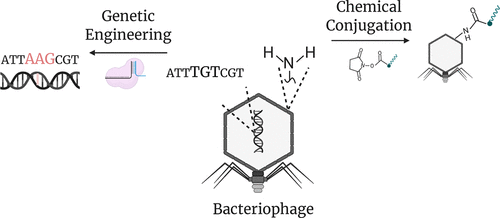当前位置:
X-MOL 学术
›
Bioconjugate Chem.
›
论文详情
Our official English website, www.x-mol.net, welcomes your
feedback! (Note: you will need to create a separate account there.)
Bacteriophage Capsid Modification by Genetic and Chemical Methods
Bioconjugate Chemistry ( IF 4.0 ) Pub Date : 2021-03-04 , DOI: 10.1021/acs.bioconjchem.1c00018 Caitlin M Carmody 1 , Julie M Goddard 1 , Sam R Nugen 1
Bioconjugate Chemistry ( IF 4.0 ) Pub Date : 2021-03-04 , DOI: 10.1021/acs.bioconjchem.1c00018 Caitlin M Carmody 1 , Julie M Goddard 1 , Sam R Nugen 1
Affiliation

|
Bacteriophages are viruses whose ubiquity in nature and remarkable specificity to their host bacteria enable an impressive and growing field of tunable biotechnologies in agriculture and public health. Bacteriophage capsids, which house and protect their nucleic acids, have been modified with a range of functionalities (e.g., fluorophores, nanoparticles, antigens, drugs) to suit their final application. Functional groups naturally present on bacteriophage capsids can be used for electrostatic adsorption or bioconjugation, but their impermanence and poor specificity can lead to inconsistencies in coverage and function. To overcome these limitations, researchers have explored both genetic and chemical modifications to enable strong, specific bonds between phage capsids and their target conjugates. Genetic modification methods involve introducing genes for alternative amino acids, peptides, or protein sequences into either the bacteriophage genomes or capsid genes on host plasmids to facilitate recombinant phage generation. Chemical modification methods rely on reacting functional groups present on the capsid with activated conjugates under the appropriate solution pH and salt conditions. This review surveys the current state-of-the-art in both genetic and chemical bacteriophage capsid modification methodologies, identifies major strengths and weaknesses of methods, and discusses areas of research needed to propel bacteriophage technology in development of biosensors, vaccines, therapeutics, and nanocarriers.
中文翻译:

通过遗传和化学方法修饰噬菌体衣壳
噬菌体是一种病毒,其在自然界中普遍存在,并且对其宿主细菌具有显着的特异性,使得农业和公共卫生领域的可调节生物技术领域令人印象深刻且不断发展。噬菌体衣壳容纳并保护其核酸,已用一系列功能(例如荧光团、纳米粒子、抗原、药物)进行修饰,以适应其最终应用。噬菌体衣壳上天然存在的官能团可用于静电吸附或生物共轭,但它们的无常性和较差的特异性可能导致覆盖和功能的不一致。为了克服这些限制,研究人员探索了遗传和化学修饰,以使噬菌体衣壳与其目标结合物之间形成牢固的特异性结合。遗传修饰方法涉及将替代氨基酸、肽或蛋白质序列的基因引入噬菌体基因组或宿主质粒上的衣壳基因,以促进重组噬菌体的产生。化学修饰方法依赖于衣壳上存在的官能团与活化的缀合物在适当的溶液pH值和盐条件下反应。本综述调查了当前遗传和化学噬菌体衣壳修饰方法的最新技术,确定了方法的主要优点和缺点,并讨论了推动噬菌体技术开发生物传感器、疫苗、治疗方法和药物的研究领域。纳米载体。
更新日期:2021-03-17
中文翻译:

通过遗传和化学方法修饰噬菌体衣壳
噬菌体是一种病毒,其在自然界中普遍存在,并且对其宿主细菌具有显着的特异性,使得农业和公共卫生领域的可调节生物技术领域令人印象深刻且不断发展。噬菌体衣壳容纳并保护其核酸,已用一系列功能(例如荧光团、纳米粒子、抗原、药物)进行修饰,以适应其最终应用。噬菌体衣壳上天然存在的官能团可用于静电吸附或生物共轭,但它们的无常性和较差的特异性可能导致覆盖和功能的不一致。为了克服这些限制,研究人员探索了遗传和化学修饰,以使噬菌体衣壳与其目标结合物之间形成牢固的特异性结合。遗传修饰方法涉及将替代氨基酸、肽或蛋白质序列的基因引入噬菌体基因组或宿主质粒上的衣壳基因,以促进重组噬菌体的产生。化学修饰方法依赖于衣壳上存在的官能团与活化的缀合物在适当的溶液pH值和盐条件下反应。本综述调查了当前遗传和化学噬菌体衣壳修饰方法的最新技术,确定了方法的主要优点和缺点,并讨论了推动噬菌体技术开发生物传感器、疫苗、治疗方法和药物的研究领域。纳米载体。











































 京公网安备 11010802027423号
京公网安备 11010802027423号